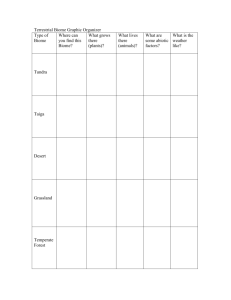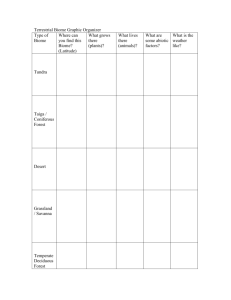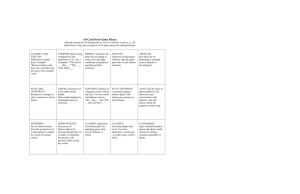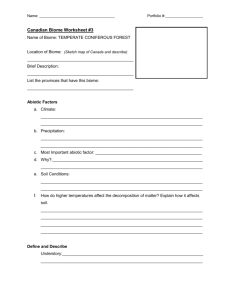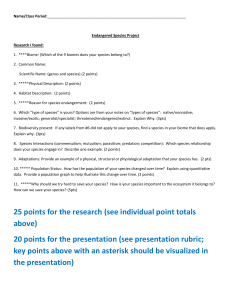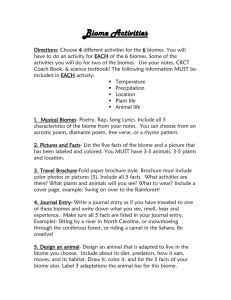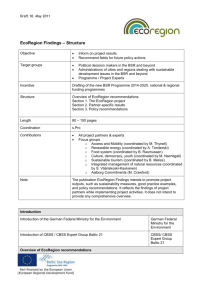Key for WWF Biome da..
advertisement
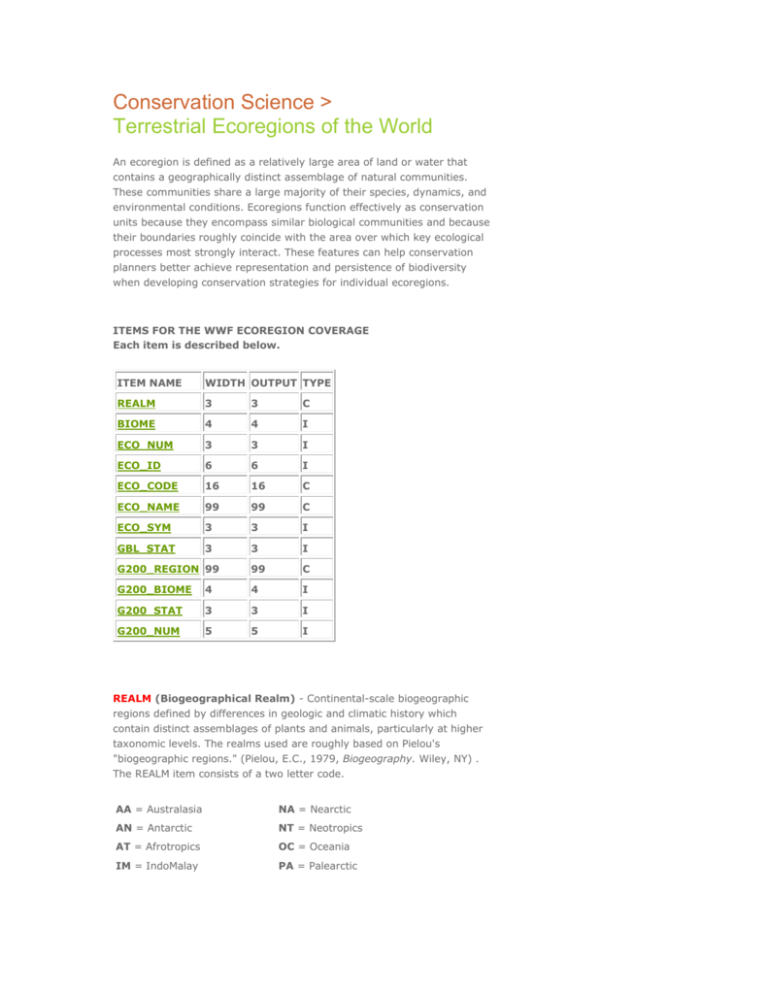
Conservation Science > Terrestrial Ecoregions of the World An ecoregion is defined as a relatively large area of land or water that contains a geographically distinct assemblage of natural communities. These communities share a large majority of their species, dynamics, and environmental conditions. Ecoregions function effectively as conservation units because they encompass similar biological communities and because their boundaries roughly coincide with the area over which key ecological processes most strongly interact. These features can help conservation planners better achieve representation and persistence of biodiversity when developing conservation strategies for individual ecoregions. ITEMS FOR THE WWF ECOREGION COVERAGE Each item is described below. ITEM NAME WIDTH OUTPUT TYPE REALM 3 3 C BIOME 4 4 I ECO_NUM 3 3 I ECO_ID 6 6 I ECO_CODE 16 16 C ECO_NAME 99 99 C ECO_SYM 3 3 I GBL_STAT 3 3 I G200_REGION 99 99 C G200_BIOME 4 4 I G200_STAT 3 3 I G200_NUM 5 5 I REALM (Biogeographical Realm) - Continental-scale biogeographic regions defined by differences in geologic and climatic history which contain distinct assemblages of plants and animals, particularly at higher taxonomic levels. The realms used are roughly based on Pielou's "biogeographic regions." (Pielou, E.C., 1979, Biogeography. Wiley, NY) . The REALM item consists of a two letter code. AA = Australasia NA = Nearctic AN = Antarctic NT = Neotropics AT = Afrotropics OC = Oceania IM = IndoMalay PA = Palearctic BIOME (Formally known as Major Habitat Types or MHTs) - Broad kinds of ecoregions that: a) Experience comparable climatic regimes; b) Have similar vegetation structure; c) Display similar spatial patterns of biodiversity; and d) Contain flora and fauna with similar guild structures and life histories. e) Similar minimum requirements and thresholds for maintaining certain biodiversity features. f) Have similar sensitivities to human disturbance. There are 14 terrestrial biomes. Each biome is given a number (1-14) shown below: 1 = Tropical & Subtropical Moist Broadleaf Forests 2 = Tropical & Subtropical Dry Broadleaf Forests 3 = Tropical & Subtropical Coniferous Forests 4 = Temperate Broadleaf & Mixed Forests 5 = Temperate Conifer Forests 6 = Boreal Forests/Taiga 7 = Tropical & Subtropical Grasslands, Savannas & Shrublands 8 = Temperate Grasslands, Savannas & Shrublands 9 = Flooded Grasslands & Savannas 10 = Montane Grasslands & Shrublands 11 = Tundra 12 = Mediterranean Forests, Woodlands & Scrub 13 = Deserts & Xeric Shrublands 14 = Mangroves ECO_NUM (Ecoregion Number) - This number is a unique number for each ecoregion within each biome nested within each realm. ECO_ID (Ecoregion ID) - This number is created by combining REALM, BIOME, and ECO_NUM, thus creating a unique numeric ID for each ecoregion. Here are two examples: Biome (100s) Eco_num (10s) Eco_ID New Caledonia Dry AA = 10000 Forest 2 = 200 2 10202 Guianan Moist Forest 1 = 100 25 60125 Ecoregion Name Realm (10,000s) NT = 60000 ECO_CODE (Ecoregion Code) - This alphanumeric field is similar to ECO_ID except that it keeps the two letter REALM code to make it more user friendly. Here are two examples: Ecoregion Name Realm Biome Eco_num Eco_Code New Caledonia Dry Forest AA 02 02 AA0202 Guianan Moist Forest 01 25 NT0125 NT ECO_NAME (Ecoregion Name) - The name of the ecoregion. ECO_SYM (Ecoregion Symbol) - This item colors the ecoregions in ArcInfo using a modified colornames shadeset. GBL_STAT (Global Status) - A 30-year prediction of future conservation status given current conservation status and trajectories. 1 = CRITICAL OR ENDANGERED 2 = VULNERABLE 3 = RELATIVELY STABLE OR INTACT G200_REGION (Global 200 Region) - Equals the name of the Global 200 ecoregion that this ecoregion is a part of. If there is no name the ecoregion is not a Global 200 ecoregion. G200_BIOME (Global 200 Biome) - The biome of the Global 200 region that the ecoregion is a component of. Occasionally a Global 200 region is made up of ecoregions of different biomes. In this case, for a particular ecoregion, the G200_BIOME may be different from the original biome. For a description of each Global 200 biome (1-14), see BIOME. G200_STAT (Global 200 Region Conservation Status) - The "Global Status" of the Global 200 ecoregions. 1 = CRITICAL OR ENDANGERED 2 = VULNERABLE 3 = RELATIVELY STABLE OR INTACT G200_NUM (Global 200 Number) - A unique number identifying Global 200 ecoregions.
